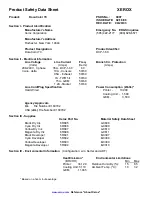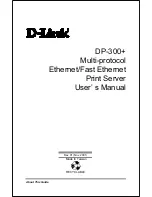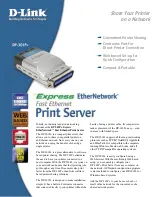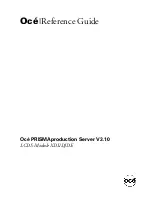
3.3.3
Bidirectional
Centronics
Interface
1. Overview
This SIDM printer is equipped with a parallel Centronics interface which is located on
the main electronic pcb. The data transfer handshake (with some smaller exceptions)
has been implemented according IEEE1284 standard. Up to now (13.12.95) only the
Nibble Mode was implemented (Bytemode, ECP-Mode and EEP mode may follow
later per request). The Nibble Mode has been adapted to meet the requirements
Microsoft Windows (TM) Operating System which does a printer identification using
“Plug’n’Play”. A graphical schematic is shown in the IEEE1284 standard picture 3,
page 25 and picture 9, page 35.
2 Detailed description of data transfer in Nibble Mode
The transmission of printer identification is divided into two parts. In the first phase
there is a “negotiation” between PC and printer to activate Nibble Mode. In the
second phase there is a data transfer. At the end of each phase there is a reentry to
to the normal Centronics mode according a defined handshake procedure. The name
“Nibble Mode” in this case means that the transmission is performed in two packages
per 4 bit in direction to the PC using existing control lines (bit 0/4=Error, Bit
1/5=Select, Bit 2/6=Paper-End, Bit 3/7=Busy). All other possible modes are using the
8 standard data lines - now in the opposite direction (printer - PC)
2.1 Phase 1, Negotiation phase
Procedure
–
The PC sets SELECTIN to high and at the same time AUTOFEED to low.
–
The printer reacts within 35ms with SELECT, ERROR and PAPEREND to high
but DONE to low
–
PC transmits one data byte to the printer with a STROBE signal and sets
AUTOFEED to high
–
This byte will be analyzed by the printer. If all seems to be ok this byte should be
00hex witch means the PC likes to know whether or not the printer is supporting
Nibble Mode.
–
Since the printer is able to run Nibble Mode the printer answers then with
SELECT, ERROR and PAPEREND to low. To create an interrupt at PC side,
DONE will be set to high at the end.
–
Now the termination of the negotiation phase will be done by setting SELECTIN
to low.
–
As a result the printer is setting SELECT and BUSY to high and after a short
delay also SELECTIN to low.
–
As a reaction AUTOFEED is set to low at PC side.
–
The printer is now setting ERROR and SELECT in normal Centronics mode
according the actual state and after that DONE is changed back again to high.
–
PC should react then setting AUTOFEED signal to high
–
As the very end of this negotiation phase the printer sets BUSY and DONE in
normal
–
Centronics mode according the actual state.
–
Now everything is in normal state.
Electronic Functions
Functional Description
3-22
Summary of Contents for T2265 SprintPro
Page 1: ...Maintenance Manual Matrix Printer T2265 SprintPro T2280 SprintPro T2155 T2170...
Page 2: ...This page intentionally left blank...
Page 8: ...This page intentionally left blank...
Page 10: ...This page intentionally left blank...
Page 30: ...right mark mark mark Mechanical Functions Functional Description 3 12...
Page 34: ...T2170 Electronic groups Electronic Functions Functional Description 3 16...
Page 35: ...T2265 T2280 Electronic groups Functional Description Electronic Functions 3 17...
Page 110: ...This page intentionally left blank...
Page 115: ...Adjustments Mechanical Adjustments 6 5...
Page 117: ...S1 default off 6 5 4 3 2 1 on Adjustments Electrical Adjustments 6 7...
Page 124: ...This page intentionally left blank...
Page 126: ...7 1 Housing Housing Spare Parts and Schematics 7 2...
Page 128: ...7 2 Basic Printer 133 1 3 Basic Printer Spare Parts and Schematics 7 4...
Page 129: ...Basic Printer 2 3 Spare Parts and Schematics Basic Printer 7 5...
Page 130: ...Basic Printer 3 3 Basic Printer Spare Parts and Schematics 7 6...
Page 133: ...This page intentionally left blank...
Page 134: ...7 3 Standard Tractor Assy Standard Tractor Assy Spare Parts and Schematics 7 10...
Page 144: ...7 8 PMS Double Sensor PMS mechanic PMS Double Sensor Spare Parts and Schematics 7 20...
Page 146: ...7 10 Option Recogition Option Recogition Spare Parts and Schematics 7 22...
Page 147: ...7 11 Sens Function Select Spare Parts and Schematics Sens Function Select 7 23...
Page 150: ...Modular Interfaces Spare Parts and Schematics 7 26...
Page 156: ...8 3 Spare Parts and Schematics Sheet Feeder Mechanic Spare Parts and Schematics 8 4...
Page 160: ...This page intentionally left blank...
Page 164: ...10 2 Tractor Complete 14 Rear Tractor Option 2T Model Tractor Complete 10 2...
Page 166: ...This page intentionally left blank...
Page 168: ...14 6 4 12 1 5 6 11 7 13 7 8 17 2 9 3 16 15 4 Cutting Device Option Specifications 11 2...
Page 170: ...This page intentionally left blank...
Page 171: ...12 2nd Front Tractor option 2nd Front Tractor option 12 1...
Page 173: ...13 Color Option Color Option 13 1...
Page 176: ...This page intentionally left blank...
















































